Looking for doorway coverings that allow easy access, light control, privacy & flow between rooms? This expert-backed guide will help you find the right curtains, shades & blinds for doorways to ensure privacy, block out light, and keep dirt and debris out while letting fresh air in.
Removable and temporary doorway covers can be used as room dividers and help to mentally separate spaces without entirely closing off space like a door would. Vertical blinds are typically hailed as practical, easy to operate, and obstruction-free options for both doored & doorless doorways.
Scroll on to learn more about the best curtains, shades, and blinds with their pros and cons to make an informed decision while buying one.
6 Best Doorway Coverings with Pros & Cons
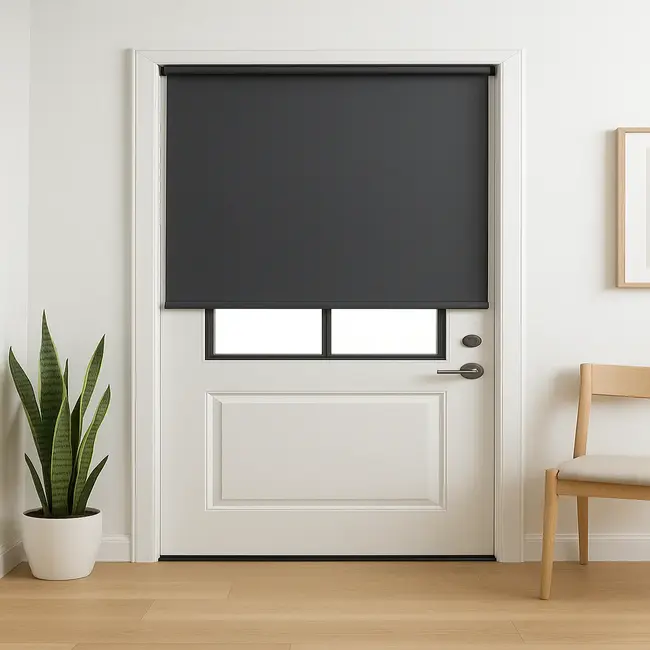
1. Zebra Light Filtering Curtains – a 2-in-1 Option for Doorways
Two-in-one door covering options like Cordless Sheer Light Filtering Zebra Curtains Elegance give you the freedom to customize light passing through the doorways, patios, and other door-like openings. With zebra-like alternating sheer and opaque slats, you can easily transition from flooding in bright natural light to total darkness, if the door is directly exposed to the sun.
Pros
- Easily adjustable between light-allowing & light-blocking opacities
- See-through & non-see-through options
- High quality construction to withstand frequent use on high traffic doorways
- Can be neatly stacked at the top to completely uncover the door opening, if needed
- Less expensive than other types of door blinds on the market.
- You can get a Sheer Light Filtering Zebra Curtain Elegance for a standard 4 ft and 6 ft tall doorway for $137.86, compared to $237.01 for a Flat Roman Curtain – Exquisite of the same size.
Cons
- Narrow light gaps possible
- Cleaning challenge for dual-layered sheer fabrics
Expert Design Tip
If you want to cover a front doorway that is exposed to gusty winds or cold drafts, our experts highly recommend thick, heavy-duty fabrics with bulky metallic headrails.
2. Beaded Door Coverings
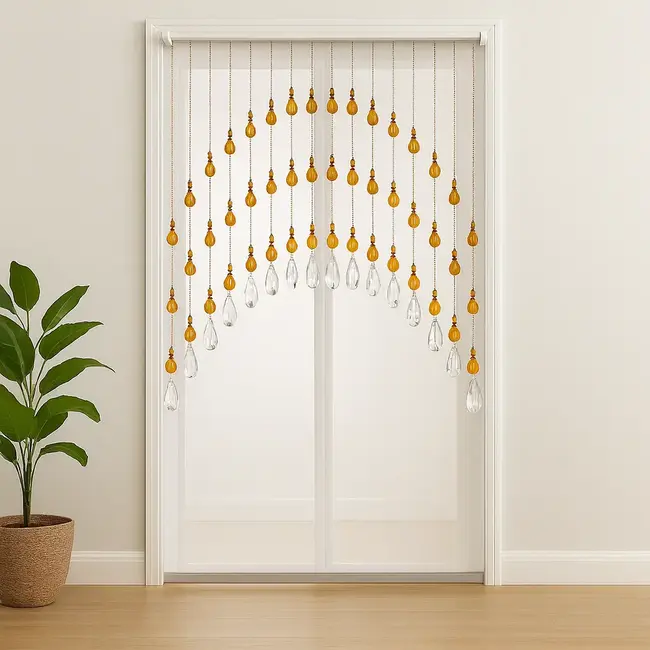
Beaded door blinds with hanging beads are genuinely aesthetic window coverings for doorways, which also provide a degree of privacy and light control.
Pros
- Breathable beaded fabric can ensure improved air circulation
- Can act as insect deterrence
- Enhanced visual interest and a degree of privacy
- Easy to hang from door frame using cup hooks
- Can be used as room dividers
- Can be split sideways when you want to walk through the door
Cons
- May not effectively block drafts, light and sound
- If corded, they can pose a serious threat of strangulation to your kid
3. Roller Blinds for Doorways
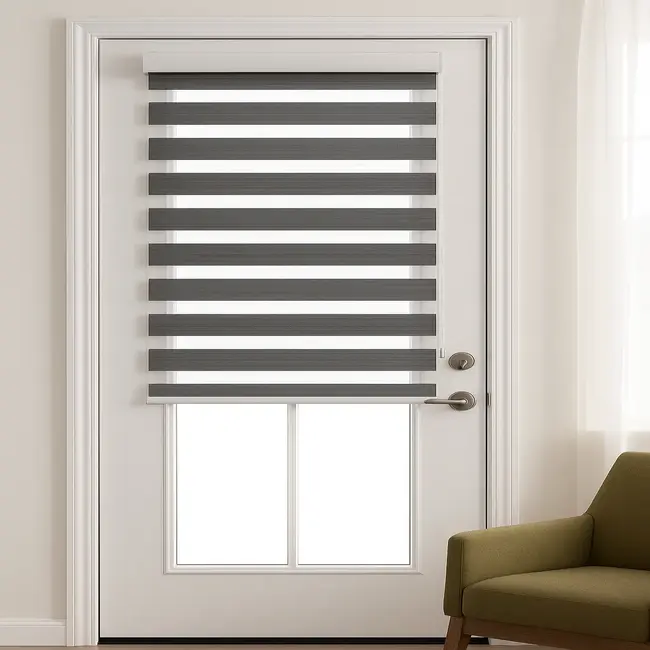
Roller blinds, like Blackout Roller Shades Exclusive, are a sleek, modern option for doorways. They can be easily retracted or rolled up to allow for unobstructed access to the next room, porch, or backyard, based on the location of the door being treated.
Pros
- Versatile, stylish window treatment for doorways
- Available in a wide range of fabrics, patterns, and colors to match any door decor
- Space-saving design for low-recess door frames
- Very affordable – a basic model of roller shades, such as Light Filtering Roller Shades Essential, will cost $110.35 for a bigger 60×84” doorway
- Made from foldless, wrinkle-free fabrics – dust resistant and easy to maintain
Cons
- May flap if the door is left open
- Fabric has to be rolled up to access the door handle
Hot Tip
If you want to block all light on your patio door, either buy a blackout roller shade or line a light filtering one with a blackout liner.
4. String Blinds for Doors
String blinds are ready-to-use coverings for doors. They are an elegant option for entrances for shops, retails stores, offices, and other commercial buildings.
Pros
- A perfect option to add a heightened decorative touch to doorways & entrances
- Allow obstruction-free to and for movement of people
- Can also be used as wall panels, room dividers, and window blinds
- Easy to install and replace
Cons
- Do not offer sufficient privacy, light control and insulation
- Susceptible to mechanical damage
5. Thermal Insulated Roman Shades for Doors
Thick-fabric Roman shades, preferably Relaxed Roman Shade – Elite Plus, have extraordinary heat and cold blocking capabilities. When installed on doors, they can keep your home darker and cooler in summer and warmer in winter. Based on our customer survey, over 60% homeowners prefer magnetic thermal insulated door curtains over their bracket-and-screw counterparts for easy hanging and unhanging for washing.
Pros
- Improved comfort and energy efficiency
- Regulate temperature and lower energy bills
- Can reduce heat loss through doorways by up to 42%
- Available as a 5-layer-system for maximum insulation benefit
Cons
- More expensive than other door covering options – a Plain Pleated Roman Shade – Exquisite will cost $266.38 to cover a 54” x 66” door
- Can be more challenging to clean than roller blinds
Design Tip
Joanna Gaines’s practical design idea of layering Roman shades with light cafe curtains works well for wide doorways for an additional style and functionality.
6. Motorized Shades for Doorways
Facing difficulty in operating blinds or shades on tall and wide doors? Also ready to spend a little extra? There is no better option than motorized shades. We always recommend Motorized Sheer Horizontal Room Darkening Shades Elite, as they can be easily stacked to the doortop with the click of a button on the wireless remote control.
Pros
- Can be integrated with your smart home automation system (like Google Home or Alexa)
- Added convenience and security (for you can open/close them when you are away from home!)
- Increased home value
Cons
- The most expensive option to cover doorways
- Reliance on uninterrupted power supply
Where to Buy Doorway Coverings from?
- Affordableblinds.com online store offers premium exterior and interior doorway coverings at affordable prices & discounts (up to 70%!)
- Hassle-free & secure online shopping experience
- Made in the US in 1 Day offer (If you place your order on Monday before 8:00 AM EST it will be made Tuesday and shipped from our factory by the end of the following business day which is Wednesday.)
- Clear privacy policy for safe data handling
- 110% best price guarantee
- Worry-Free Fit Policy: We’ll take up part of the cost to get your problem resolved, if you mismeasure your patio door.
- A Free (Limited) Lifetime Guarantee for long-term peace of mind
- 100% Satisfaction Guarantee with 5-star customer care
- Return/refund policy
How to Measure
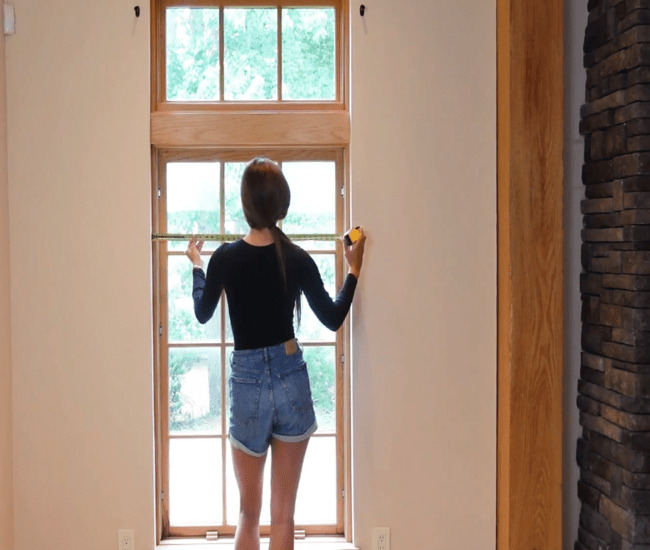
Read our DIY step-by-step guide on how to measure doorway opening for curtains, blinds and shades.
Note: Do not make any deductions for inside mount doorway blinds. We – at AffordableBlinds.com – will do it for you!
Installation Instructions
For a professional, inch-by-inch fit, follow our step-by-step DIY guide on how to install window treatments in doorways.
Installation Time
13 to 15 minutes
Care & Maintenance
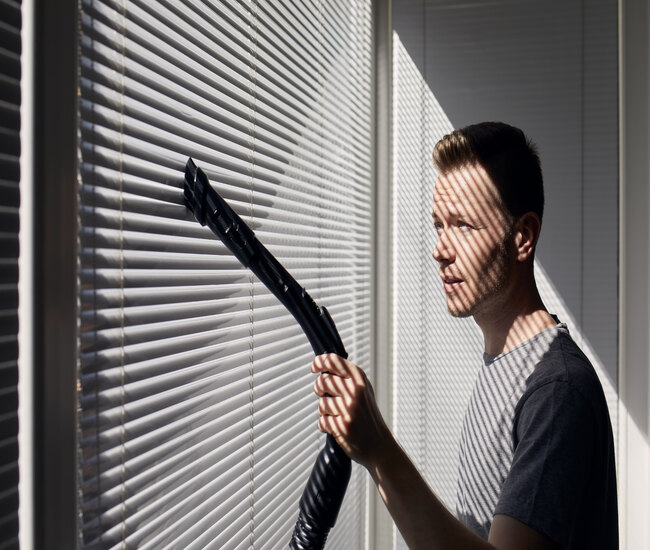
You can keep your doorway coverings clean and in mint condition with regular dusting or vacuuming. For detailed instruction, read our guide on cleaning all types of blinds & shades.
FAQs
How to cover a doorless doorway?
- Step 1: Install the curtain’s hanging hardware above your doorless doorway’s jamb.
- Step 2: Hang the curtains, shades, or drapes the same way you would as if covering a window or a door.
- Step 3: Add tie-backs at the sides of the doorless opening for the times when you’d like to see into the next room.
What are Japanese doorway curtains called?
Japanese doorway curtains are called noren. Noren or traditional Japanese fabric curtains are hung in doorways, in windows, on walls or between rooms as dividers. These Japanese doorway curtains typically have one or more slits, cut vertically from the bottom to nearly the top of the fabric, which allow for easier viewing or passage through the doorway.
Why do Japanese hang curtains in doorways?
- Japanese curtains or noren appeared during the Heian Period (794-1185) and they’re originally hung in doorways to keep the houses cool in summer, or retain heat during winter.
- Nowadays, they’re used as a type of doorway curtains or room dividers, acting as a temporary wall, providing a sense of privacy, and separating spaces without completely closing them off.
- Japanese curtains can also help regulate temperature, block light and dust, and add a decorative touch to an interior.
- Another purpose of Japanese curtains is to act as an advertisement, showing a brand’s name or logo.
Why do people have beads in doorways?
Beaded curtains originally appeared in the 1960’s, so they’re used to symbolize the attitudes of the era. It was believed that “only walls between people are as easily moveable as a curtain of beads”.
What blinds allow you to see out but not in?
Solar roller shades with 14% openness factor will provide open-window-like visibility without letting the people on the outside to see in, especially when the sun is shining on the exterior. For nighttime privacy, you can add a privacy liner. If you can keep the lights off at night, then it’s okay without a liner.
What is the current trend in blinds?
- Eco-friendly blinds with minimalist designs, made from natural materials
- Smart motorization technology for unmatched convenience and safety
- Neutral & muted colors to create calmer and more serene living spaces
- A mix of soft pastels and earthy tones to add a sense of tranquility and elegance to interiors.
What are the disadvantages of integral blinds?
- Limited design option – fewer choices for the doorway’s decor.
- Fewer light customization options.
- Hard to repair.
- A more expensive option than the standard removable blinds.
- If the mechanism fails, you’ll need to replace the entire doorway unit.
What is the best window dressing for an office?
Light filtering double cellular shades are the perfect option for offices and home offices. They increase productivity with softly diffused, glare-free natural light, blocking harmful UV rays, and ensuring thermal regulation. They’re also an affordable option compared to Roman shades, wood blinds, and shutters.
What are the options for impact-resistant blinds for sliding glass doors?
If you want to cover a patio or sliding glass door at the entrance of your commercial building, vertical blinds are both a cost-effective and impact-resistant option. They are also inherently practical as the vertical slats move in the same direction as doors. Shutters are, however, the most impact-resistant option, but they are not as practical as vertical blinds.
How much should I pay to have blinds installed?
While it is possible to install commercial shades and blinds using simple tools (screwdriver and drill), we recommend hiring a professional for a safe, high-quality installation. A professional blind installer typically charges between $60 to $80 per hour (or $30 to $40 per window). A standard window (in a residential or commercial building) takes 20 to 30 minutes to fit.
Need More Help?
Need design consultation or deals and discounts about doorway coverings? We invite you to 24/7 live chat. Or contact us at (800) 863-6109, or customerservice@affordableblinds.com for further assistance.

Leave a Reply